Empa cellulose 3D printing advances yield guidelines for composite material tuning
3D Printing News Sliced: SHINING 3D, BeAM, Lulzbot, Stratasys, Koffin
 The last Sliced 3D printing news digest of the week, today we feature, a story that brings new meaning for 3D printing a cradle to grave file; new business partnerships from Nano Dimension, EOS, and Authentise; a $9 million research fund; and other additive manufacturing applications, research and hardware releases. Latest business partnerships Process automation […]
The last Sliced 3D printing news digest of the week, today we feature, a story that brings new meaning for 3D printing a cradle to grave file; new business partnerships from Nano Dimension, EOS, and Authentise; a $9 million research fund; and other additive manufacturing applications, research and hardware releases. Latest business partnerships Process automation […]3D Printing News Briefs: October 13, 2018
We’ve got business and education news galore in today’s 3D Printing News Briefs. First, Voodoo Manufacturing has launched its new Shopify app, and BeAM Machines is partnering with Empa, while Sculpteo is working with a property developer to provide 3D printed apartment models. VSHAPER has signed an agreement with educational publisher Grupa MAC, and the United Arab Emirates is introducing 3D printing into over 200 of its primary schools. The US Navy will be testing the first 3D printed ship component, and Lufthansa Technik has established a new Additive Manufacturing Center. Finally, maker Thomas Sanladerer shared on YouTube about his recent visit to the Prusa headquarters.
Voodoo Manufacturing Launches Shopify App
 This spring, high-volume 3D printing factory Voodoo Manufacturing began its full-stack manufacturing and fulfillment service for 3D printing entrepreneurs, which allows users to outsource work like quality control and assembly for their products through its easy shopfront integrations with online marketplaces like Shopify. Now, the company has launched its own Shopify app, which will allow online sellers to create and customize 3D printed products and sell them on their own Shopify stores. Once the app is installed, users can make their first product in less than 5 minutes, which is then automatically added to their store, ready for purchase.
This spring, high-volume 3D printing factory Voodoo Manufacturing began its full-stack manufacturing and fulfillment service for 3D printing entrepreneurs, which allows users to outsource work like quality control and assembly for their products through its easy shopfront integrations with online marketplaces like Shopify. Now, the company has launched its own Shopify app, which will allow online sellers to create and customize 3D printed products and sell them on their own Shopify stores. Once the app is installed, users can make their first product in less than 5 minutes, which is then automatically added to their store, ready for purchase.
“We wanted to make it ridiculously easy for ecommerce stores to diversify their product offering with 3D printed products. By applying 3D printing to the print-on-demand business model, we are opening up an infinite range of product categories for Shopify merchants,” said Max Friefeld, the Founder and CEO of Voodoo Manufacturing. “The Voodoo app provides a new source of high quality, customizable, on-demand products, that don’t require any 3D design experience.”
Before the official launch this week, Voodoo piloted the service with a group of beta users, including It’s The Island Life by graphic designer and Guam native Lucy Hutcheson. She is already successfully selling six different products made with the help of the new Voodoo app.
BeAM Machines Partnering with Empa
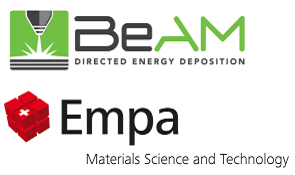 BeAM, recently acquired by AddUp, has signed a research and development agreement with Empa, the Swiss Federal Laboratories for Materials Science and Technology. Together, the two will develop novel applications for BeAM’s powder-based Directed Energy Deposition (DED) technology, which uses focused thermal energy to fuse materials by melting them while they’re deposited. This makes parts manufacturing much faster. The partnership has come on the heels of Empa’s acquisition of a BeAM DED 3D printer, which is located at its Laboratory for Advanced Materials Processing in Thun and is used to integrate and test out innovative components.
BeAM, recently acquired by AddUp, has signed a research and development agreement with Empa, the Swiss Federal Laboratories for Materials Science and Technology. Together, the two will develop novel applications for BeAM’s powder-based Directed Energy Deposition (DED) technology, which uses focused thermal energy to fuse materials by melting them while they’re deposited. This makes parts manufacturing much faster. The partnership has come on the heels of Empa’s acquisition of a BeAM DED 3D printer, which is located at its Laboratory for Advanced Materials Processing in Thun and is used to integrate and test out innovative components.
Patrik Hoffmann, who leads the laboratory, said, “We are very excited to collaborate with BeAM’s engineers to push the boundaries of this innovative additive manufacturing technology and to develop a whole new range of applications for Swiss industries and beyond.”
Sculpteo 3D Printing Apartment Models
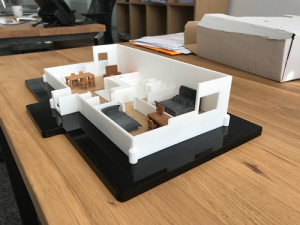 Together with Sculpteo, French property developer Valoptim is working to improve customer experience by providing clients with miniaturized 3D printed models of their future apartments when they sign their contracts, so they can better visualize and prepare for moving into their new home. These small, exact replicas give new owners an immersive experience, which is a definite value add. In addition, production of the 3D printed models is local, and can be done fast.
Together with Sculpteo, French property developer Valoptim is working to improve customer experience by providing clients with miniaturized 3D printed models of their future apartments when they sign their contracts, so they can better visualize and prepare for moving into their new home. These small, exact replicas give new owners an immersive experience, which is a definite value add. In addition, production of the 3D printed models is local, and can be done fast.
“Sculpteo uses the best machines and 3D printing processes on the market today. At first, we had the ambition to test the feasibility of 3D printing in the real estate sector. This innovative process has proven to be extremely interesting: the realistic rendering, with high-end finishes, allowed our clients to discover a miniaturized version of their future apartment enabling them to realistically imagine themselves living in it,” said Edouard Pellerin, CEO of Valoptim. “This innovation contributes to our business dynamic: constantly improving the customer experience.”
VSHAPER and Grupa Mac Sign Agreement
 Polish 3D printer manufacturer Verashape has signed an agreement with Grupa MAC, the country’s top educational publisher, in front of Poland’s education curators at the recent Future of Education Congress. Per the agreement, Grupa MAC will use a network of educational consultants to distribute the VSHAPER GO 3D printers to kindergartens and other schools in the country. Grupa MAC recognizes that 3D printers are a good way to quickly present the effects of students’ learning, and the VSHAPER GO is the perfect choice, as it is easy to use and comes with an intuitive interface of SOFTSHAPER software.
Polish 3D printer manufacturer Verashape has signed an agreement with Grupa MAC, the country’s top educational publisher, in front of Poland’s education curators at the recent Future of Education Congress. Per the agreement, Grupa MAC will use a network of educational consultants to distribute the VSHAPER GO 3D printers to kindergartens and other schools in the country. Grupa MAC recognizes that 3D printers are a good way to quickly present the effects of students’ learning, and the VSHAPER GO is the perfect choice, as it is easy to use and comes with an intuitive interface of SOFTSHAPER software.
“Classes with students are a perfect environment for the use of 3D Printing. Creating a pyramid model for history lessons, the structure of a flower or a human body for biology lessons are just a few examples, and their list is limited only by the imagination of students and teachers,” said Patryk Tomczyk, a member of the Grupa MAC Management Board. “We are happy that thanks to our cooperation with VERASHAPE, 3D Printers have a chance to reach schools through our network of educational consultants.”
3D Printing to be Introduced in UAE Primary Schools
 Speaking of 3D printing in education, the Ministry of Education (MoE) for the UAE has announced that in early 2019, a country-wide introduction of 3D printing into over 200 primary schools will commence. As part of this new technology roll out, Dubai education consultancy company Ibtikar is partnering with Makers Empire, an Australian education technology company, to deliver a program that implements 3D printing and design. Makers Empire will supply 3D software, curriculum, teacher resources, training, and support to Ibtikar, which will in turn train MoE teachers to deliver the program.
Speaking of 3D printing in education, the Ministry of Education (MoE) for the UAE has announced that in early 2019, a country-wide introduction of 3D printing into over 200 primary schools will commence. As part of this new technology roll out, Dubai education consultancy company Ibtikar is partnering with Makers Empire, an Australian education technology company, to deliver a program that implements 3D printing and design. Makers Empire will supply 3D software, curriculum, teacher resources, training, and support to Ibtikar, which will in turn train MoE teachers to deliver the program.
“Through this rollout of 3D technology, our students will learn to reframe needs as actionable statements and to create solutions to real-world problems,” said HE Eng. Abdul Rahman of the United Arab Emirates Ministry of Education. “In doing so, our students will develop an important growth mindset, the skills they need to make their world better and the essential ability to persist when encountering setbacks.”
US Navy Approves Test of First 3D Printed Shipboard Part
The US military has long explored the use of 3D printing to lower costs and increase the availability of spare parts. Huntington Ingalls Industries, the largest military shipbuilder in the US, has also been piloting new technologies, like 3D printing, as part of its digital transformation. In collaboration with the US Navy, the company’s Newport News Shipbuilding division has worked to speed the adoption of 3D printed metal components for nuclear-powered warships. This has led to an exciting announcement by the Naval Sea Systems Command (NAVSEA): a metal drain strainer orifice (DSO) prototype has officially been approved as the first 3D printed metal part to be installed on a US Navy ship. The assembly is a component for the steam system, which allows for drainage and removal of water from a steam line while in use. The 3D printed DSO prototype will be installed on the USS Harry S. Truman in 2019 for evaluation and tests. After one year, the assembly will be removed for inspection and analysis.
“This install marks a significant advancement in the Navy’s ability to make parts on demand and combine NAVSEA’s strategic goal of on-time delivery of ships and submarines while maintaining a culture of affordability. By targeting CVN 75 [USS Harry S. Truman], this allows us to get test results faster, so-if successful-we can identify additional uses of additive manufacturing for the fleet,” said Rear Adm. Lorin Selby, NAVSEA Chief Engineer and Deputy Commander for Ship Design, Integration, and Naval Engineering.
Lufthansa Technik Opens New Additive Manufacturing Center
 Lufthansa Technik, a leading provider of maintenance, repair and overhaul (MRO) for civil aircraft, has established a new Additive Manufacturing Center. The goal of the new AM Center is to bundle and expand the company’s experience and competence with the technology, which can be used to make individual parts more quickly and with more design freedom. As the world of aircraft is always aware of weight, making more lightweight parts is an excellent benefit of 3D printing.
Lufthansa Technik, a leading provider of maintenance, repair and overhaul (MRO) for civil aircraft, has established a new Additive Manufacturing Center. The goal of the new AM Center is to bundle and expand the company’s experience and competence with the technology, which can be used to make individual parts more quickly and with more design freedom. As the world of aircraft is always aware of weight, making more lightweight parts is an excellent benefit of 3D printing.
“The new AM Center will serve as a collaborative hub where the experience and skills that Lufthansa Technik has gained in additive manufacturing can be bundled and further expanded,” said Dr. Aenne Koester, the head of the new AM Center. “The aim is to increase the degree of maturity of the technologies and to develop products that are suitable for production.”
Tom’s 3D Visits Prusa Headquarters
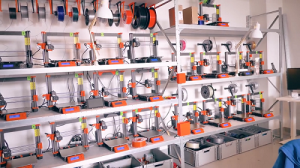 Maker Thomas Sanladerer, who runs his own YouTube channel, recently had the chance to tour the Prusa Research headquarters in Prague. Not only did he get the opportunity to see how the company makes its popular MK3 and and MK2.5, but Sanladerer was also able to see early models of the company’s recently announced SL1 resin 3D printer, as well as the Prusament filament production line.
Maker Thomas Sanladerer, who runs his own YouTube channel, recently had the chance to tour the Prusa Research headquarters in Prague. Not only did he get the opportunity to see how the company makes its popular MK3 and and MK2.5, but Sanladerer was also able to see early models of the company’s recently announced SL1 resin 3D printer, as well as the Prusament filament production line.
“I always find factory tours like this super interesting because it’s the only chance you really get of seeing behind the scenes of what might really just be a website, or you know, a marketing video or whatever,” Sanladerer said in his video.
Sanladerer took the tour of the Prusa factory right after Maker Faire Prague, which the company itself organized and sponsored. To see behind the scenes of Prusa for yourself, check out the rest of the video below:
Discuss these stories and other 3D printing topics at 3DPrintBoard.com or share your thoughts below.
Optomec Opens New EMEA Operations Center in Switzerland

Dave Ramahi, Urs Berger- Optomec, Harald Moder- Merconics, Lars Sommerhäuser & Pierangelo Gröning, Empa- at the Coating Competency Center at Empa in Switzerland [Image: Optomec]
New Mexico-based company Optomec has been around since 1997, and has gotten a lot accomplished in those 21 years. The company is known for two major 3D printing technologies. Aerosol Jet 3D printing enables the printing of electronics, using aerodynamic focusing to precisely and accurately deposit electronic inks onto substrates. The ink is placed into an atomizer, which creates a dense mist of material laden droplets; that mist is then delivered to the deposition head where it is focused by a sheath gas, which surrounds the aerosol as an annular ring. When the sheath gas and aerosol pass through the nozzle, they accelerate and the aerosol becomes focused into a tight stream, which is then aimed at the substrate.
Optomec’s other technology, LENS, is a metal 3D printing method, using a high-powered laser to fuse metal powder into dense 3D structures. The process takes place in a hermetically sealed chamber which is purged with argon so that the oxygen and moisture levels stay below 10 parts per million, keeping the part clean and preventing oxidation. The powder is delivered to the deposition head by a proprietary powder feed system which can precisely regulate mass flow.
![]() Just recently, Optomec introduced a new technology – a hybrid system that combines LENS technology with CNC milling. The company is consistently developing new innovations, and is always expanding – Optomec has now announced that it is opening Optomec GmbH, a new Europe, Middle East and Africa (EMEA) Operations Center located in Dübendorf, Switzerland. Optomec GmbH will be located at Empa, the Swiss Federal Laboratories for Materials Science and Technology. Empa is an institution of the ETH domain and is affiliated with the ETH Zürich (Swiss Federal Institute of Technology).
Just recently, Optomec introduced a new technology – a hybrid system that combines LENS technology with CNC milling. The company is consistently developing new innovations, and is always expanding – Optomec has now announced that it is opening Optomec GmbH, a new Europe, Middle East and Africa (EMEA) Operations Center located in Dübendorf, Switzerland. Optomec GmbH will be located at Empa, the Swiss Federal Laboratories for Materials Science and Technology. Empa is an institution of the ETH domain and is affiliated with the ETH Zürich (Swiss Federal Institute of Technology).
Empa has been responsible for some big 3D printing innovations itself, especially in the materials department. It’s also the location of the DFAB House, a project involving multiple digital construction technologies including 3D printing.
“Recognized for its leading-edge research in materials science and interdisciplinary technology, Empa is an ideal setting for Optomec to establish its EMEA Operations Center,” said Mike Kardos, VP World Wide Sales at Optomec. “Our office and demo center will be staffed with engineers and service technicians as well as the latest equipment to better support our partners and grow our customer base in the region. Also, our partnership with Empa enables Optomec to leverage their extensive network of European partnerships and collaborate on research activities that are well aligned with Optomec’s technology roadmap.”
 Empa employs about 1,000 people and is dedicated to research and development in the field of sustainable materials science and technology.
Empa employs about 1,000 people and is dedicated to research and development in the field of sustainable materials science and technology.
“The new EMEA office demonstrates Optomec’s commitment to growing our presence and serving our clients in this region,” said Urs Berger, Optomec Director of Sales for EMEA. “I’m pleased to play an integral role in this expansion and look forward to the exciting development opportunities this presents for our clients and our industry.”
Discuss this and other 3D printing topics at 3DPrintBoard.com or share your thoughts below.
3D printing news Sliced: 3D Systems, Optomec, Luxexcel, Local Motors
Sand 3D Printing Used to Create Smart Slab Ceiling for ETH Zurich’s DFAB House
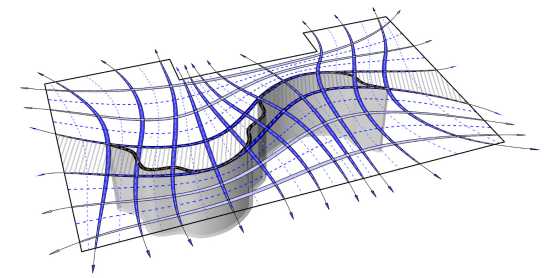 Last year, a project began, led by ETH Zurich and centered around the fabrication of a multi-story house called the DFAB House. The structure would showcase multiple technologies being developed at the university, including a 3D sand printing technique. Now the team has completed what is known as the Smart Slab, a panel that will be the DFAB House’s ceiling. At its thinnest point, the Smart Slab is only 20 mm thick, but it’s strong, and while it wasn’t 3D printed directly, the mold for the slab was made from a 3D sand printer, making it the first full-scale architectural project to use 3D sand printing for its formwork.
Last year, a project began, led by ETH Zurich and centered around the fabrication of a multi-story house called the DFAB House. The structure would showcase multiple technologies being developed at the university, including a 3D sand printing technique. Now the team has completed what is known as the Smart Slab, a panel that will be the DFAB House’s ceiling. At its thinnest point, the Smart Slab is only 20 mm thick, but it’s strong, and while it wasn’t 3D printed directly, the mold for the slab was made from a 3D sand printer, making it the first full-scale architectural project to use 3D sand printing for its formwork.
The ceiling is 80 meters squared, weighs 15 tonnes and consists of 11 concrete segments that connect the lower floor with the two-story timber space above. One advantage of using 3D printing for the mold instead of using a direct layer-by-layer concrete process is that high performant fiber-reinforced concrete can be used, and it can be fabricated with millmeter precision.
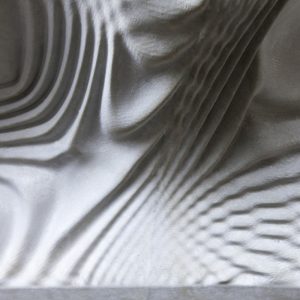 The Smart Slab was developed by the research group of Benjamin Dillenburger, Assistant Professor for Digital Building Technologies at ETH Zurich. The group developed a new software to create the formwork elements; the software is able to record and coordinate all parameters relevant to production. The team entered basic data such as room dimensions as well as a scan of the curved wall that will support the ceiling. This allowed them to adapt the geometry of the slab so that at each point it was applied only as thick as structurally necessary to support the force flow.
The Smart Slab was developed by the research group of Benjamin Dillenburger, Assistant Professor for Digital Building Technologies at ETH Zurich. The group developed a new software to create the formwork elements; the software is able to record and coordinate all parameters relevant to production. The team entered basic data such as room dimensions as well as a scan of the curved wall that will support the ceiling. This allowed them to adapt the geometry of the slab so that at each point it was applied only as thick as structurally necessary to support the force flow.
“We didn’t draw the slab; we programmed it,” said Mania Aghaei Meibodi, Smart Slab project lead and senior researcher in Dillenburger’s group. “It would not have been possible to coordinate all these aspects with analogue planning, particularly with such precision.”
The ceiling is composed of ribs of different sizes. The main ribs carry the loads, while the smaller filigree ribs are primarily for acoustics and aesthetic appeal. The lighting and sprinkler systems are integrated directly into the slab structure; they were coordinated with the planning software as well.
Several partners worked on the Smart Slab after its design had been exported from the computer. One industry partner produced the 3D printed sand formworks, which were divided into pallet-sized sections for easier printing and transport. Another partner fabricated the timber formwork through CNC machining, which gives shape to the upper part of the Smart Slab and leaves hollow areas that reduce weight and create space for electrical cables. A third partner brought together the two types of formwork, spraying the fiber-reinforced concrete onto the sand formwork to produce the lower concrete shell and casting the remaining concrete into the timber formwork.
The 11 individual concrete segments were transported to be building site after hardening for two weeks. A crane placed the concrete elements onto the load-bearing wall, where the prestressing took place. Steel cables were pulled lengthwise and crosswise through the concrete support and into the channels already inserted in the formwork. Tensioning the cables significantly increases the system’s load capacity.
“It was spectacular to see on the construction site how seamlessly our elements fitted with each other and with the existing components of the DFAB House,” said Dillenburger. “We owe this in part to the outstanding interdisciplinary collaboration with our partners. The meticulous work that we had invested into planning completely paid off.”
ETH Zurich has become well-known for its work with advanced 3D printing and robotics research. The university has developed numerous new digital fabrication technologies, several of which are being utilized in the construction of the DFAB House. The house is being constructed at Empa and Eawag‘s NEST research and innovation facility. You can learn more about the DFAB House here.
Discuss this and other 3D printing topics at 3DPrintBoard.com or share your thoughts below.
[Images: ETH Zurich]


